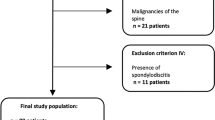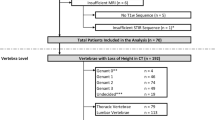Abstract
Magnetic resonance imaging (MRI) is degraded by metal-implant-induced artifacts when used for the diagnostic assessment of vertebral compression fractures in patients with instrumented spinal fusion. Dual-energy computed tomography (DECT) offers a promising supplementary imaging tool in these patients. This case report describes an 85-year-old woman who presented with a suspected acute vertebral fracture after long posterior lumbar interbody fusion. This is the first report of a vertebral fracture that showed bone marrow edema on DECT; however, edema was missed by an MRI STIR sequence owing to metal artifacts. Bone marrow assessment using DECT is less susceptible to metal artifacts than MRI, resulting in improved visualization of vertebral edema in the vicinity of fused vertebral bodies.



Similar content being viewed by others
References
Adams JE. Opportunistic identification of vertebral fractures. J Clin Densitom. 2016; 19(1):54–62. doi:10.1016/j.jocd.2015.08.010.
Christiansen BA, Bouxsein ML. Biomechanics of vertebral fractures and the vertebral fracture cascade. Curr Osteoporos Rep. 2010;8(4):198–204. doi:10.1007/s11914-010-0031-2.
Hernlund E, Svedbom A, Ivergard M, et al. Osteoporosis in the European Union: medical management, epidemiology and economic burden. A report prepared in collaboration with the International Osteoporosis Foundation (IOF) and the European Federation of Pharmaceutical Industry Associations (EFPIA). Arch Osteoporos. 2013;8:136. doi:10.1007/s11657-013-0136-1.
Felsenberg D, Silman AJ, Lunt M, et al. Incidence of vertebral fracture in Europe: results from the European Prospective Osteoporosis Study (EPOS). J Bone Miner Res Off J Am Soc Bone Miner Res. 2002;17(4):716–24. doi:10.1359/jbmr.2002.17.4.716.
Ettinger B, Black DM, Nevitt MC, et al. Contribution of vertebral deformities to chronic back pain and disability. J Bone Miner Res. 1992;7(4):449–56. doi:10.1002/jbmr.5650070413.
Lips P, Cooper C, Agnusdei D, et al. Quality of life in patients with vertebral fractures: validation of the Quality of Life Questionnaire of the European Foundation for Osteoporosis (QUALEFFO). Working Party for Quality of Life of the European Foundation for Osteoporosis. Osteoporos Int. 1999;10(2):150–60.
Alexandru D, So W. Evaluation and management of vertebral compression fractures. Perm J. 2012;16(4):46–51.
Bergmann M, Oberkircher L, Bliemel C, Frangen TM, Ruchholtz S, Kruger A. Early clinical outcome and complications related to balloon kyphoplasty. Orthop Rev. 2012;4(2):e25. doi:10.4081/or.2012.e25.
Garfin SR, Buckley RA, Ledlie J. Balloon kyphoplasty for symptomatic vertebral body compression fractures results in rapid, significant, and sustained improvements in back pain, function, and quality of life for elderly patients. Spine (Phila Pa 1976). 2006;31(19):2213–20. doi:10.1097/01.brs.0000232803.71640.ba.
Griffith JF. Identifying osteoporotic vertebral fracture. Quant Imaging Med Surg. 2015;5(4):592–602. doi:10.3978/j.issn.2223-4292.2015.08.01.
Muller GM, Lundin B, von Schewelov T, Muller MF, Ekberg O, Mansson S. Evaluation of metal artifacts in clinical MR images of patients with total hip arthroplasty using different metal artifact-reducing sequences. Skeletal Radiol. 2015;44(3):353–9. doi:10.1007/s00256-014-2051-y.
Takrouri HS, Alnassar MM, Amirabadi A, et al. Metal artifact reduction: added value of rapid-kilovoltage-switching dual-energy CT in relation to single-energy CT in a piglet animal model. AJR Am J Roentgenol. 2015;205(3):W352–9. doi:10.2214/ajr.14.12547.
Diekhoff T, Kiefer T, Stroux A, et al. Detection and characterization of crystal suspensions using single-source dual-energy computed tomography: a phantom model of crystal arthropathies. Invest Radiol. 2015;50(4):255–60. doi:10.1097/rli.0000000000000099.
Huppertz A, Hermann KG, Diekhoff T, Wagner M, Hamm B, Schmidt WA. Systemic staging for urate crystal deposits with dual-energy CT and ultrasound in patients with suspected gout. Rheumatol Int. 2014;34(6):763–71. doi:10.1007/s00296-014-2979-1.
McCollough CH, Leng S, Yu L, Fletcher JG. Dual- and multi-energy CT: principles, technical approaches, and clinical applications. Radiology. 2015;276(3):637–53. doi:10.1148/radiol.2015142631.
Ravanfar Haghighi R, Chatterjee S, Tabin M, et al. DECT evaluation of noncalcified coronary artery plaque. Med Phys. 2015;42(10):5945. doi:10.1118/1.4929935.
Toprover M, Krasnokutsky S, Pillinger MH. Gout in the spine: imaging, diagnosis, and outcomes. Curr Rheumatol Rep. 2015;17(12):70. doi:10.1007/s11926-015-0547-7.
Wilhelm K, Schoenthaler M, Hein S, et al. Focused dual-energy CT maintains diagnostic and compositional accuracy for urolithiasis using ultra-low dose non-contrast CT. Urology. 2015. doi:10.1016/j.urology.2015.06.052.
Piazzolla A, Solarino G, Lamartina C, et al. Vertebral bone marrow edema (VBME) in conservatively treated acute vertebral compression fractures (VCFs): evolution and clinical correlations. Spine (Phila Pa 1976). 2015;40(14):E842–8. doi:10.1097/brs.0000000000000973.
Bierry G, Venkatasamy A, Kremer S, Dosch JC, Dietemann JL. Dual-energy CT in vertebral compression fractures: performance of visual and quantitative analysis for bone marrow edema demonstration with comparison to MRI. Skeletal Radiol. 2014;43(4):485–92. doi:10.1007/s00256-013-1812-3.
Guggenberger R, Gnannt R, Hodler J, et al. Diagnostic performance of dual-energy CT for the detection of traumatic bone marrow lesions in the ankle: comparison with MR imaging. Radiology. 2012;264(1):164–73. doi:10.1148/radiol.12112217.
Pache G, Krauss B, Strohm P, et al. Dual-energy CT virtual noncalcium technique: detecting posttraumatic bone marrow lesions—feasibility study. Radiology. 2010;256(2):617–24. doi:10.1148/radiol.10091230.
Reagan AC, Mallinson PI, O’Connell T, et al. Dual-energy computed tomographic virtual noncalcium algorithm for detection of bone marrow edema in acute fractures: early experiences. J Comput Assist Tomogr. 2014;38(5):802–5. doi:10.1097/rct.0000000000000107.
Wang CK, Tsai JM, Chuang MT, Wang MT, Huang KY, Lin RM. Bone marrow edema in vertebral compression fractures: detection with dual-energy CT. Radiology. 2013;269(2):525–33. doi:10.1148/radiol.13122577.
Pache G, Bulla S, Baumann T, et al. Dose reduction does not affect detection of bone marrow lesions with dual-energy CT virtual noncalcium technique. Acad Radiol. 2012;19(12):1539–45. doi:10.1016/j.acra.2012.08.006.
Jepperson MA, Cernigliaro JG, el Ibrahim SH, Morin RL, Haley WE, Thiel DD. In vivo comparison of radiation exposure of dual-energy CT versus low-dose CT versus standard CT for imaging urinary calculi. J Endourol. 2015;29(2):141–6. doi:10.1089/end.2014.0026.
Author information
Authors and Affiliations
Corresponding author
Ethics declarations
The patient presented here was examined in the setting of a prospective clinical study evaluating DECT in vertebral fractures. The institutional review board approved this study. Informed consent was obtained for participation.
Rights and permissions
About this article
Cite this article
Fuchs, M., Putzier, M., Pumberger, M. et al. Acute vertebral fracture after spinal fusion: a case report illustrating the added value of single-source dual-energy computed tomography to magnetic resonance imaging in a patient with spinal Instrumentation. Skeletal Radiol 45, 1303–1306 (2016). https://doi.org/10.1007/s00256-016-2419-2
Received:
Revised:
Accepted:
Published:
Issue Date:
DOI: https://doi.org/10.1007/s00256-016-2419-2




